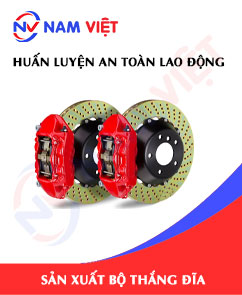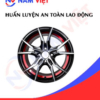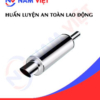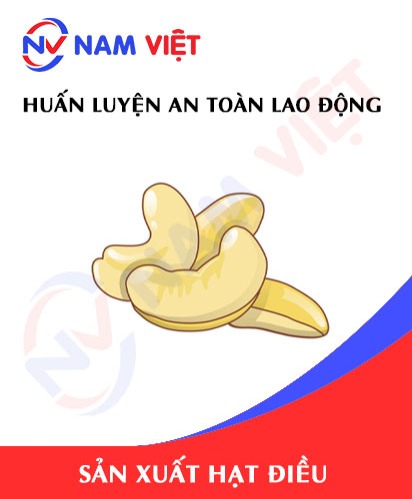Occupational Safety Training for Disc Brake Manufacturing
99,000 ₫
Note: The above price is calculated per person and may vary depending on the number of trainees participating in the course and market fluctuations. For more accurate pricing information, please refer to the price list or contact our consultants directly.
Occupational safety is an important issue in disc brake manufacturing factories and needs to be addressed promptly to ensure the health and safety of workers, as well as to enhance the reputation of businesses. The Occupational Safety Training course is an effective solution to raise awareness about accident prevention for workers involved in disc brake production.
Table of Contents
Toggle1. Overview of Disc Brake Set
a. What is a Disc Brake Set?
A disc brake set is a braking system commonly used on vehicles such as bicycles, motorcycles, and cars. The disc brake set includes several main components such as the brake rotor (disc), caliper, brake pads, and other related parts. When the rider or driver presses the brake, the brake pads press against the brake rotor, creating friction that slows down and stops the vehicle.
Brake rotors are usually made of steel or alloy, offering high durability and good heat dissipation, which helps the braking system perform more effectively compared to other types of brakes. The caliper contains pistons which, when actuated by hydraulic or mechanical force, push the brake pads against the rotor. Brake pads are typically made from high-friction materials to ensure optimal braking performance.
Disc brake sets offer many advantages such as strong braking power, stable performance under various weather conditions, and less wear compared to other braking systems. However, they also have some drawbacks like higher cost and more frequent maintenance requirements.

b. Machinery for Disc Brake Set Production
- CNC Lathe Machine: CNC lathes are used to machine round parts of the disc brake set, especially the brake rotors. This machine allows for highly precise cutting, producing smooth surfaces and accurate dimensions.
- CNC Milling Machine: CNC milling machines are often used to process complex parts of calipers and brake pads. With the ability to create precise and complex cuts, CNC milling ensures high quality and durability of the products.
- Grinding Machine: Grinding machines are used to finish the surfaces of parts, ensuring they are flat and polished as needed. Specifically, grinding is commonly used to treat brake rotors to improve braking efficiency and reduce noise during braking.
- Hydraulic Press: Hydraulic presses are used to press components of the disc brake set together, such as assembling brake pads into the caliper. This machine ensures components are securely and accurately assembled.
- Die Casting Machine: Die casting machines are used to cast metal parts like calipers. The casting process creates parts with complex shapes and uniform dimensions while enhancing strength and load-bearing capacity.
- Quality Inspection Machine: After machining, disc brake parts must undergo quality inspection using machines such as Coordinate Measuring Machines (CMM), hardness testers, and other testing devices. This ensures the products meet high standards of quality and safety.

c. Famous Disc Brake Set Brands
- Brembo: Brembo is one of the most famous global brands in braking systems, especially disc brakes. Brembo products are widely used in sports cars, racing cars, and luxury vehicles due to their superior quality and excellent braking performance.
- Bosch: Bosch is a major German technology corporation providing many automotive products and solutions, including disc brake sets. Bosch brakes are known for high durability and reliable safety features.
- Akebono: Akebono is a renowned Japanese brand in the brake industry. They supply disc brake sets for both cars and motorcycles, noted for advanced technology and stable performance under various conditions.
- TRW: TRW (now part of ZF Friedrichshafen AG) is another well-known brand in brake system manufacturing. TRW offers high-quality disc brake sets for a range of vehicles from economy to luxury cars.
- EBC Brakes: EBC Brakes is a UK-based brand famous for brakes used on motorcycles and cars. EBC offers disc brake sets in various product lines, from standard brakes to high-performance brakes used in racing.
- Nissin: Nissin is a leading Japanese manufacturer specializing in brake systems for motorcycles and cars. Nissin products are widely used on motorcycles from many well-known brands and are highly regarded for quality and performance.
- Wilwood: Wilwood is an American brand specializing in brake systems for racing and high-performance vehicles. Wilwood products are designed to withstand harsh operating conditions and deliver optimal braking performance.

d. Specific Jobs in a Disc Brake Set Manufacturing Plant
Group 1
- Executive directors, deputy executive directors, department heads in the disc brake set manufacturing plant.
Group 2
- Safety officers: manage safety within the plant, design safety procedures, supervise and enforce employees to comply with safe work processes.
Group 3
- CNC lathe and CNC milling machine operators: Responsible for machining metal parts with high precision according to approved designs.
- Grinders: Perform surface grinding of parts after machining to ensure smoothness and precision of the products.
- Foundry workers: Operate die casting machines to create complex parts such as calipers from metal or alloys.
- Assembly workers: Responsible for assembling components of the disc brake set following standard procedures. This includes fitting brake pads into calipers, inspecting and assembling brake rotors.
- Quality control inspectors: Conduct inspections on dimensions, shapes, and accuracy of parts after machining and assembly. Use measuring devices such as CMM, hardness testers, and other inspection tools.
Group 4
- Office work, service, sales, marketing.
- Production management, quality management, human resource management, materials management, financial and accounting management.
- Research and development of new products, design of packaging and product models.
2. Overview of the Occupational Safety Training Course for Disc Brake Production
Within the scope of this article, we focus on issues related to Group 3, because Group 3 is the group directly involved in the production process, facing the highest occupational safety risks. For more information on other groups, see here.
a. What is Group 3 Occupational Safety Training?
- Group 3 Occupational Safety Training consists of sessions that equip workers with awareness on how to prevent workplace accidents.
- The occupational safety training course helps workers identify and avoid hazards, reducing the risks of occupational accidents during work.
REGISTER FOR OCCUPATIONAL SAFETY TRAINING SERVICE
b. Training Duration
Initial occupational safety training duration
- Total training time is at least 24 hours, including assessment time.
- 8 hours of theory on the system of occupational safety and hygiene policies and laws
- 8 hours of theory on basic knowledge of occupational safety and hygiene
- 4 hours of theory on specialized training content
- 2 hours of practical training on specialized content
- 2 hours of theory assessment at the end of the training course
The safety training center schedules multiple sessions depending on workers’ availability. Usually, there are 6 training sessions over 3 days, provided the manufacturing company arranges continuous study time.
Periodic occupational safety training duration
- Before the occupational safety card expires, workers who want to renew must attend a periodic occupational safety training course, with periodic training duration at least 50% of the initial training duration.
Explanation: The total periodic occupational safety training time is at least 12 hours, including assessment time. After completing the periodic training and passing the test, workers will be reissued or have their occupational safety card extended.
c. Training Content
| No. | TRAINING CONTENT | TRAINING DURATION (HOURS) | |||
| Total | Including | ||||
| Theory | Practice | Assessment | |||
| I | System of occupational safety and hygiene policies and laws | 8 | 8 | 0 | 0 |
| 1 | Overview of the system of legal documents on occupational safety and hygiene. | 6 | 6 | ||
| 2 | System of occupational safety and hygiene standards and technical regulations. | 1 | 1 | ||
| 3 | Specific regulations of state management agencies on occupational safety and hygiene when constructing, expanding, or renovating works, facilities for production, usage, preservation, storage, and inspection of machinery, equipment, materials, and substances with strict occupational safety and hygiene requirements. | 1 | 1 | ||
| II | Basic knowledge of occupational safety and hygiene | 8 | 8 | 0 | 0 |
| 1 | Basic knowledge of hazardous and harmful factors in the workplace. | 4 | 4 | ||
| 2 | Methods to improve working conditions. | 1 | 1 | ||
| 3 | Safety culture in production and business. | 1 | 1 | ||
| 4 | Rights and obligations of employers and employees; occupational safety and hygiene policies and regimes for employees; functions and duties of the occupational safety and hygiene network. | 1 | 1 | ||
| 5 | Occupational safety and hygiene regulations, safety signs and instructions, use of safety equipment and personal protective gear; first aid skills for occupational accidents, prevention of occupational diseases. | 1 | 1 | ||
| III | Specialized training content | 6 | 4 | 2 | 0 |
| Comprehensive knowledge about types of machinery, equipment, and substances generating hazardous and harmful factors; analysis, evaluation, and risk management in occupational safety and hygiene; safe working procedures with machinery, equipment, and substances with strict occupational safety and hygiene requirements. | 6 | 4 | 2 | ||
| IV | Assessment of occupational safety training content at the end of the course | 2 | 2 | 0 | 0 |
| Total | 24 | 22 | 2 | ||
See more training content of the 6 groups
d. Occupational Safety Card
After completing the occupational safety training course and passing the assessment, workers will be issued an occupational safety card (commonly referred to as a Group 3 occupational safety certificate).
The Group 3 safety card clearly shows information such as full name, date of birth, job, and specific work environment. It also includes training duration, official stamp, and signature confirming course completion.
According to regulations on card issuance specified in Clause 2 of Article 24 of Decree 44/2016/ND-CP, there are two cases:
- If the employer and employee have a labor contract, the employer must sign, stamp, and seal the safety card for the Group 3 trained employee after completing the training and passing the assessment from the occupational safety training unit.
- If the worker is freelance, seasonal, or does not have a labor contract, the training unit must sign, stamp, and seal the safety card for the worker after completing training and passing the assessment from the occupational safety training unit.

3. Identifying Hazards Affecting Workers in Disc Brake Production
- Mechanical hazards:
- Machinery and equipment: Workers may be injured from contact with moving parts of CNC lathes, CNC milling machines, grinders, and casting machines. Accidents such as finger or limb entrapment, cuts, or lacerations can occur if safety procedures are not followed.
- Sharp materials: Sharp metal fragments from machining processes may cause cuts or puncture wounds.
- Chemical hazards:
- Chemical exposure: Workers may be exposed to chemicals used in production, such as cutting oils, solvents, and cleaning agents. Prolonged or unprotected exposure can lead to skin irritation, dermatitis, or respiratory issues.
- Fumes and metal dust: Machining and grinding can generate metal dust and harmful fumes that affect the respiratory system if not properly controlled and ventilated.
- Physical hazards:
- Noise: Machinery and equipment often produce high noise levels, which can damage hearing if workers do not use ear protection.
- Vibration: Metalworking equipment may generate strong vibrations, causing fatigue and musculoskeletal problems with prolonged exposure.
- Thermal hazards:
- High temperatures: Processes like metal casting and machining generate high heat, posing burn risks if workers lack thermal protection.
- Ergonomic hazards:
- Poor working posture: Tasks requiring awkward or repetitive movements cause muscle fatigue, back pain, and spinal issues.
- Electrical hazards:
- Electric shock: Machinery powered by high voltage poses a risk of electric shock in case of faults or if electrical safety rules are ignored.

4. Safety Measures When Participating in Disc Brake Set Production
- Training and Raising Safety Awareness:
- Initial and periodic training: Workers need to be trained on safe working procedures, how to use personal protective equipment (PPE), and how to recognize potential hazards during production.
- Communication and education: Enhance safety awareness through discussions, safety bulletins, and instructional materials.
- Use of Personal Protective Equipment (PPE):
- Cut-resistant gloves: Protect hands from sharp materials and cuts during machining.
- Safety glasses and masks: Protect eyes and face from metal dust, debris, and hazardous chemicals.
- Hearing protection: Use earplugs or protective earmuffs to reduce the harmful effects of loud machine noise.
- Protective clothing and safety shoes: Ensure workers wear protective clothing and footwear to fully protect the body from mechanical, thermal, and chemical hazards.
- Safe Work Procedures:
- Establish and comply with safety procedures: Develop detailed and safe work processes for each production stage, ensuring workers understand and strictly follow them.
- Regular maintenance and inspection of machinery: Conduct periodic checks, maintenance, and repairs to ensure equipment operates safely and efficiently.
- Monitoring and risk assessment: Frequently assess potential hazards during production and promptly update preventive measures.
- Improving the Work Environment:
- Ventilation and dust control systems: Ensure the factory has good ventilation and effective dust control to minimize respiratory risks for workers.
- Lighting and temperature: Provide adequate lighting and appropriate temperature to enhance work performance and reduce accident risks.
- Periodically conduct work environment monitoring in factories, collecting and analyzing harmful factors to adjust and reduce risks, thereby preventing occupational diseases for workers.
- Electrical Safety Measures:
- Inspection and maintenance of electrical systems: Perform regular checks and maintenance to prevent electric shock hazards.
- Use of safe electrical equipment: Ensure all electrical devices are used properly and comply with electrical safety regulations.
- Safe Management and Storage of Chemicals:
- Proper use and storage of chemicals: Ensure all chemicals are used and stored according to safety guidelines, avoiding direct contact and spill risks.
- Provision of fire-fighting equipment: Provide adequate fire-fighting equipment and ensure workers know how to use it.
5. Benefits of Occupational Safety Training for Disc Brake Set Production
An Toàn Nam Việt offers your business the following great benefits upon completing occupational safety training courses in accordance with Decree 44/2016/ND-CP on occupational safety and hygiene for companies and enterprises.
- Workers can recognize potential occupational accident hazards and take preventive measures to avoid accidents.
- Your business can establish risk prevention measures in production, operation, and maintenance processes.
- Minimize costs related to safety incidents in labor.
- Uninterrupted production increases labor productivity and product quality.
- Compliance with labor safety laws avoids legal risks.
- Build credibility and professionalism in all aspects, thereby elevating your company’s brand.
Nam Việt’s training courses are solutions to prevent and combat external factors affecting individuals, helping them avoid dangers that could lead to injury or worse, death.
REGISTER FOR OCCUPATIONAL SAFETY TRAINING SERVICE
6. Customer Feedback After Completing Occupational Safety Training for Disc Brake Set Production
An Toàn Nam Việt has many years of experience accompanying numerous enterprises across Vietnam in general and southern provinces in particular. This responsibility is very precious to Nam Việt, which is why our Occupational Safety Training efforts are increasingly professional. Our growth is driven by positive feedback and suggestions from our business partners. Below are some testimonials from clients we have served.
Hoa Dat Construction and Trading Joint Stock Company
“Nam Việt’s service greatly helped simplify occupational safety and complete safety documentation for work processes. The consultant team responded promptly and enthusiastically to our questions. 5 stars for Nam Việt.”
See more customer interviews after using An Toàn Nam Việt’s services
7. An Toàn Nam Việt’s Occupational Safety Training Capabilities
An Toàn Nam Việt is a reputable and quality occupational safety training center in Vietnam. Our training sessions are continuously held at manufacturing workshops, factories, or construction sites across all 63 provinces of Vietnam.
REGISTER FOR OCCUPATIONAL SAFETY TRAINING SERVICE
Occupational Safety Training License
- An Toàn Nam Việt has been inspected and certified by the Department of Safety under the Ministry of Labor – Invalids and Social Affairs as qualified to conduct occupational safety and hygiene training. This further strengthens our training capacity.

Training Materials and Lectures
- Before training materials are introduced in occupational safety training courses, they are reviewed and approved to ensure accuracy and effectiveness.
- The teaching methods of instructors are standardized according to An Toàn Nam Việt’s curriculum, developed by experts in occupational safety and hygiene training to maximize knowledge absorption for learners.
Facilities
- Controlling classroom factors affecting training improves teaching efficiency and student knowledge retention.
- Our training support facilities include spacious classrooms meeting standards for area, lighting, and training equipment, etc.
8. Nationwide Reputable and Quality Safety Training Center
At An Toàn Nam Việt, we always prioritize professional dedication to occupational safety training. For us, imparting knowledge on self-protection to workers equips them with safety on their livelihood journey, contributing to national development.
To ensure effective training, we carefully prepare every detail, from tools, teaching equipment, curricula, materials, sound, to lighting.
Our occupational safety instructors are experts with many years of experience. Some have even conducted research identifying hazards across various industries and ways to prevent them.
Our lectures are based on practical experience and delivered vividly and clearly to workers. These factors help learners feel comfortable and absorb knowledge effectively. Of course, all content strictly follows Decree 44/2016/ND-CP.
Thus, workers learn many hazard prevention measures and how to protect themselves, applying them appropriately in real work situations.
Our training center proudly provides reputable, professional occupational safety training services with advantages such as:
- Competitive training costs while ensuring quality.
- Flexible training schedules adapted to company production.
- Fast and lawful certification procedures.
- Experienced and seasoned instructors.
- Classroom environments controlled for optimal learning efficiency.
- Training materials tailored to workplace safety requirements.
- An Toàn Nam Việt works dedicatedly and professionally to provide customers with accurate and prompt support.

9. Additional Reference Materials for Occupational Safety Training in Disc Brake Set Production
- Occupational Safety Training Document Set
- Occupational Safety Training Test Set
- Occupational Safety Documents for Disc Brake Set Production
- Occupational Safety Training Curriculum for Disc Brake Set Production
- Occupational Safety Multiple Choice Test for Disc Brake Set Production
No comments yet















Review Occupational Safety Training for Disc Brake Manufacturing
There are no reviews yet.